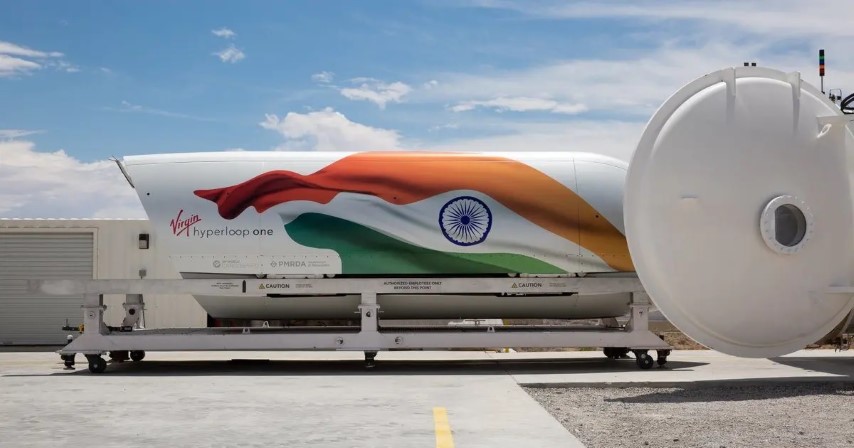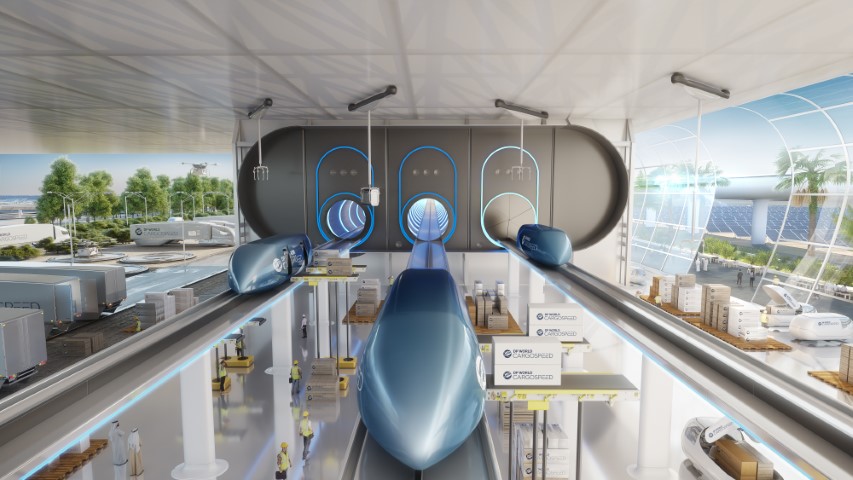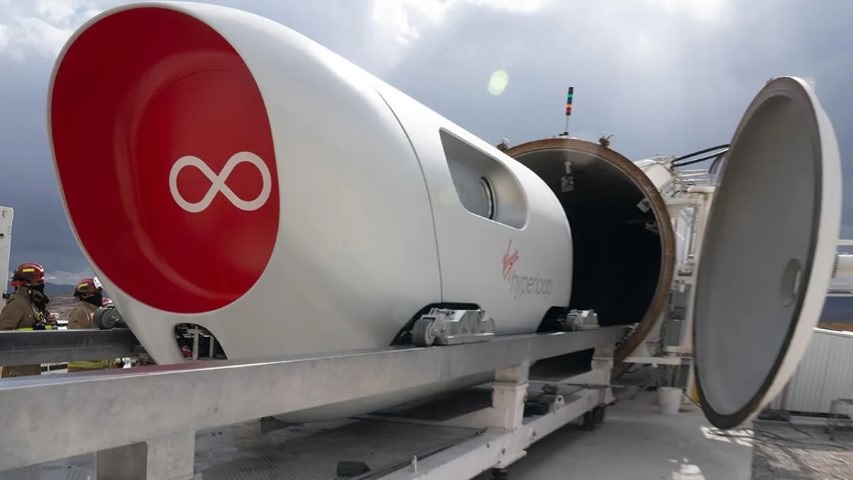Established in 2014 and undergoing a rebranding in 2017, Virgin Hyperloop One aims to revolutionize the way we think of transport. The concept is actually built on the dreams of Massachusetts born physicist engineer and inventor Robert Goddard from way back in 1910 but since then we haven't seen anything quite like it. The race is on with various companies competing to be the first to offer Hyperloop travel and Virgin may just be the one but
What exactly is the Hyperloop One?
The concept is based on a futuristic sounding levitating pod which travels through hundreds of miles of tunnels and tubes linking cities in minutes at speeds of up to 760 miles per hour. This low turbulence and entirely autonomous service is designed to be quiet direct and on-demand. It's a fusion of the three most efficient ways of travelling combining the directness of a train, the speed of a plane and the comfort and privacy of your own car although we're likely to see larger pots with room for up to 28. For many it seems a far cry from reality the type of concept that would appear in late 1900s films alongside floating cars and robots.
For Virgin Hyperloop One it is a not too distant reality. The company's publicly stated goal is for the system to be in place by 2022 or 2023 and to be rolling out more and more routes globally each year. The idea is to transport a mix of people and cargo helping to remove the polluting road traffic from our landscapes.
Let's take a look back at some of the most important events in the Hyperloop’s development. Summer 2016 saw the company open a 100000 square foot tooling and machine shop in Las Vegas, the epicenter of current Hyperloop activity. This is where parts are created which are later used at the Vegas based dev loop. This developer's loop is made up of a 500 meter course designed to demonstrate the prototype's key features. Vacuum propulsion, its control systems and structures. Pretty much one year after the engineer's shop opened images of the first pod were revealed.
Also Read: How Space Tourism Will Work | Space Tourism Explained in detail
This first generation prototype went on to be used at the dev loop helping the company to understand the logistics an dynamics of what they were dreaming to create. Just a few weeks later the pod codenamed Xp1 completed a 300 meter test run reaching speeds of up to 192 miles per hour.
Autumn rolled in, as did big news for the company. A once in a lifetime investment partnership was born between Hyperloop One and Richard Branson's Virgin group. The company subsequently renamed to Virgin Hyperloop One as Branson entered the board of directors becoming chairman.
A year and a half later, by early 2019 the company had raised around 400 million dollars as a result of a series of large investors including French state-owned railway network SNCF but where are we likely to see this?
The summer of 2016 saw Hyperloop One announce a deal with DP World as the third largest ports operator globally. This would provide them with the opportunity to come up with a cargo off-loading system which is expected to be developed for the company's flagship Jabil Ali port in Dubai. Since then other feasibility studies have also taken place in the United Arab Emirates. By the end of the following year, Finland, Sweden, The Netherlands, Switzerland, Moscow and the UK were all being subject to various feasibility studies suggesting the potential trials of the Hyperloop in these countries too.
Estonia was later added to the list with a Virgin Hyperloop One signing an agreement of intent to help with the Helsinki Italian tunnel crossing the Gulf of Finland. Further agreements of intent have been struck in India and even various American airports.
The first 10 Hyperloops were agreed upon in late 2017 spanning across five countries the winning route in the states consisted of Chicago to Pittsburgh via Columbus, Dallas to Lorido to Houston, Cheyenne to Denver to Pueblo and Miami to Orlando.
The shortlist of British winners was made up of just two routes Edinburgh to London and Glasgow to Liverpool.
Also Read: Virgin Galactic Supersonic Mach 3 Jet Details, The Future of Air Travel
This is particularly interesting with work having already started for the north south high speed rail line known as HS2 which aims to connect the capital with other major cities further. North phase one of this may be completed by 2026 with work continuing into the 2030s allowing plenty of time for Virgin Hyperloop One to obtain a foothold in the British travel market. Canada is in the pipeline for a single route linking Toronto to Montreal via Ottawa. While Mexico's proposition is to link Mexico city to Guadalajara. Finally our two proposed routes in India both starting in the city of Chennai a shorter route runs to Bangalore while the primary route connects the city with Mumbai.
To understand how the Hyperloop works and what causes it to levitate, we need to understand the basic principles of electric motors where an electric motor is used inn EV, it comprises two key components; A Rotor and A Stator. Put simply, The Rotor rotates while the Stator remains stationary. When an electric current passes through one half of the Stator, the Rotor is made to spin through the power of magnetic. In a car and most other applications the Rotor is disc or donut shaped and is surrounded by the Stator. The Virgin Hyperloop One takes a similar mode of creating energy but employs a linear motor which acts as a rail to guide the pod along its journey.
Unlike a conventional train, the pod does not need to be in contact with any rail so sits on a set of wheels. When in motion the pod levitates through the tube making physical contact with nothing. It's even claimed that minimal energy is required and this is because a chain of vacuum pumps removes almost all the air inside the tube further benefits include almost utter silence and minimal turbulence owing to the fact that it runs entirely off electric power, there are no direct emissions from the pods themselves. The environmental impact comes from the source of this electricity for example in the use of fossil fuels.
The modular and scalable benefits of this type of transport means that power sources can vary. In some parts, the roof of the tube can be covered in solar panels for example which is particularly useful for the company's future in places like the UAE. Reaching speeds faster than most aeroplanes the real benefit for the consumer is the time saved. Take San Francisco to Los Angeles for example both the cities are within California but a drive would mean to spend six hours on the road. Flights are quicker about an hour and a half but these are expensive and polluting. Virgin Hyperloop One should halve this time again completing the journey in about 45 minutes.
Just recently Virgin Hyperloop One added to the history books with the first ever trial with people inside. Although some 400 journeys have already been successfully completed at the dev loop, this was the first time any humans had travelled inside a pot. These humans were chief technology officer Josh Giesel and director of passenger experience Sarah Lucian. Branson watching via a live stream from his own home was excited and proud to be watching the team begin the next stage of transportation history.
This must be slightly frustrating for Tesla and SpaceX CEO Elon Musk who envisaged his Hyperloop design back in 2012.
His proposition to connect Los Angeles and San Francisco was said to be more efficient, cheaper, safer and faster than the high-speed rail link. In fact for cities within 900 miles of one another. Musk sees Hyperloop transport as the perfect solution further distance he says is best covered by air rather than magnetic levitation. Musk's plan is to sit the pods on a series of Air Skis making operation more similar to an Air Hockey Puck however there's one thing both companies can agree on and that's the use of a linear electric motor.
Also Read: Is Elon Musk working on an Electric Plane?
The LA to San Fran route would come in at a cool 6 billion according to his estimates lead documents. On Virgin's part suggest a price tag of 9 to 13 billion but it's hard to draw a comparison given that both of these developments are in their infancies.
Hyperloops connecting cities and communities around the world are far off yet. We expect to see some movement in terms of the first routes towards the end of the decade and into the 2030s although this seems a distant future, the reality is that Virgin is working on this today and it's the most advanced development of Hyperloop transport yet even ahead of Elon Musk. Do you think we'll be ready for fully autonomous high-speed transport as early as next decade? and more importantly what does this mean for the future of transport as we know it?
What will happen to trains planes and even personal cars? Do let us know your thoughts on it in the comment box below. Thanks for reading.









0 Comments